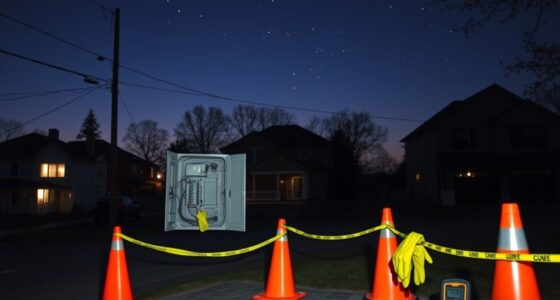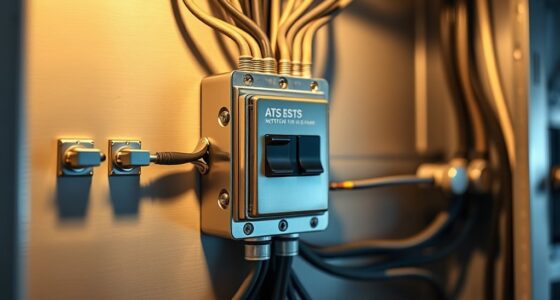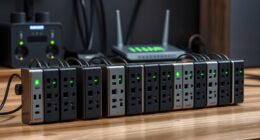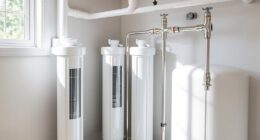Interlock kits and transfer switches help you safely connect a generator to your home’s electrical system. Interlock kits are budget-friendly and simple to install, relying on mechanical barriers to prevent backfeed, but they need manual operation. Transfer switches, especially automatic ones, offer seamless power switching and full electrical isolation, providing enhanced safety and convenience—though they cost more and often require professional installation. Keep exploring to see which option fits your needs best.
Key Takeaways
- Interlock kits are manual, mechanical devices that prevent simultaneous operation of main and generator breakers, while transfer switches provide automatic or manual electrical switching.
- Transfer switches offer full electrical isolation and advanced safety features, reducing backfeed risks, unlike interlock kits that rely on mechanical barriers.
- Interlock kits are cheaper and easier to install, suitable for DIY projects, whereas transfer switches often require professional electrician installation due to complexity.
- Automatic transfer switches provide seamless power switching during outages, offering greater convenience and control than manual interlock systems.
- Both systems must meet safety standards like NEC codes; choosing depends on budget, convenience, safety needs, and system compatibility.
Understanding the Basic Functions of Interlock Kits and Transfer Switches
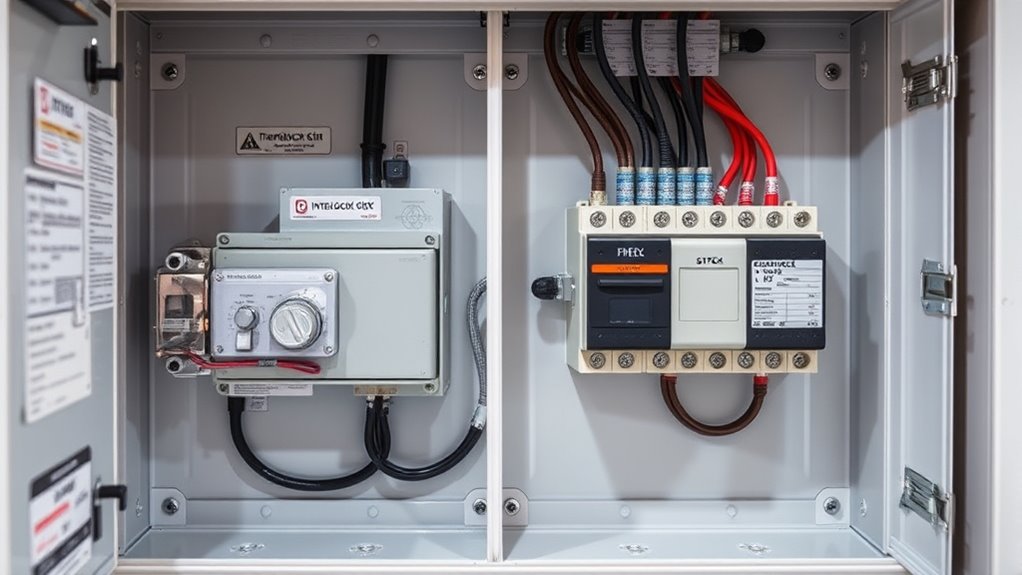
To understand how interlock kits and transfer switches work, it’s important to recognize that both devices serve as safety mechanisms to prevent dangerous backfeed into the utility grid. Interlock kits mechanically block the simultaneous operation of the main breaker and generator breaker, ensuring only one source supplies power. Transfer switches, on the other hand, electrically and mechanically isolate utility and generator sources, so only one powers your home at a time. They are designed to protect utility workers and your electrical system from backfeed hazards, often with built-in sensing features. Manual interlock kits require you to switch sources physically, while automatic transfer switches detect power loss and switch sources without your intervention. Both systems aim to keep your setup safe and compliant with electrical codes, but they do so with different mechanisms. Additionally, interlock kits are generally more affordable and easier to install than transfer switches, making them a popular choice for many homeowners seeking a cost-effective solution. Understanding electrical safety is crucial when choosing between these options to ensure proper installation and operation.
Installation Challenges and Requirements for Each System
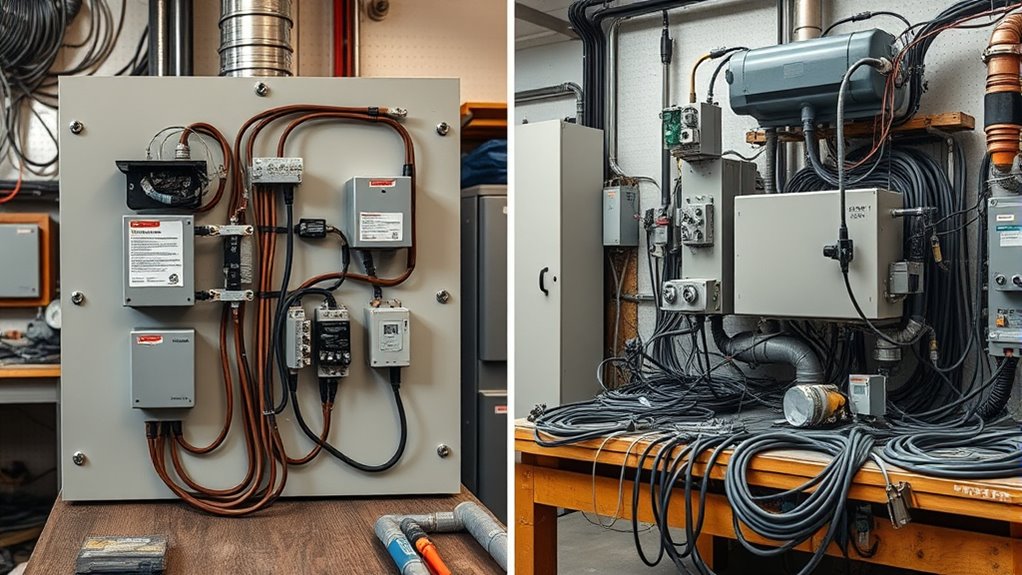
Installing interlock kits and transfer switches presents distinct challenges that can impact safety, cost, and complexity. With interlock kits, you must shut off the main breaker to guarantee the panel is de-energized, and precise alignment of the device with the main and generator breakers is critical. You’ll need to drill panel cover holes carefully, attach components securely with specific hardware, and follow manufacturer instructions closely. Testing afterward is essential to prevent backfeed hazards. For transfer switches, the process generally requires a licensed electrician due to complexity, including running new wiring, mounting the switch near the main panel, and complying with electrical codes. Both systems demand specific tools, safety gear, and attention to detail, but transfer switch installation involves more extensive electrical work and coordination with utility regulations. Additionally, understanding projector installation requirements can help ensure a safe and effective setup when integrating power backup systems.
Cost Differences and Budget Considerations
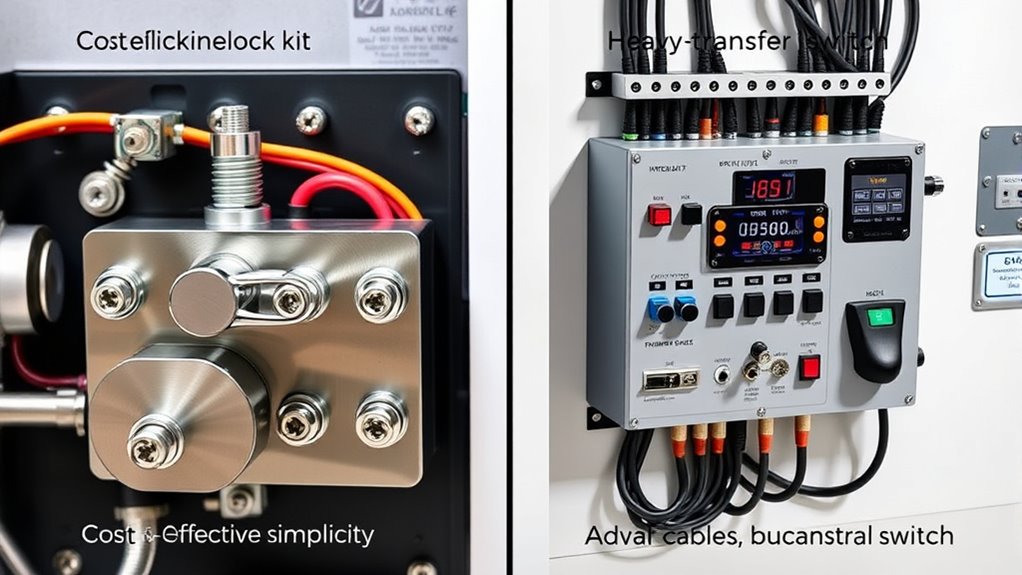
Cost differences between interlock kits and transfer switches can substantially impact your budget, especially considering initial investment and ongoing expenses. Interlock kits generally cost between $200 and $1,100, including installation, making them a budget-friendly option. Manual transfer switches are priced around $200 to $800, while automatic transfer switches range from $400 to over $2,800, reflecting higher upfront costs due to advanced features and complex installation. Interlock kits are simpler mechanically, reducing both purchase and labor costs, especially if you install them yourself. Transfer switches often require dedicated circuits and professional installation, increasing expenses. While transfer switches offer durability and future expandability, interlock kits provide essential power control at a lower initial price, aligning with budget-conscious needs for powering select circuits during outages.
Safety Features and Compliance Standards
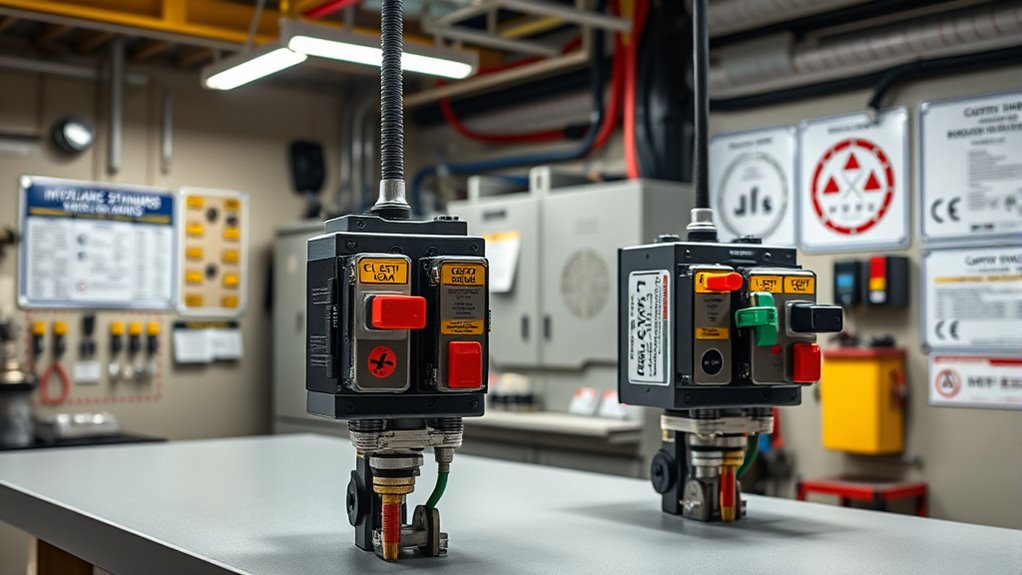
Both interlock kits and transfer switches are designed to prevent backfeeding hazards, which can send dangerous generator power back into utility lines. Transfer switches provide full electrical isolation between the generator and utility, eliminating backfeeding risks entirely. Interlock kits rely on mechanical lockouts that prevent simultaneous operation of main and generator breakers but don’t guarantee complete isolation. Improper installation or misuse of interlock kits increases the risk of accidental backfeeding, especially since they depend on manual operation. Transfer switches often include safety features like automatic shut-off when utility power returns, reducing human error. Both systems must comply with the NEC and local codes. Professional installation by licensed electricians ensures safety, system integrity, and adherence to standards, especially for critical or commercial applications. Additionally, understanding the safety features and standards associated with each system helps ensure proper functioning and compliance over time.
Ideal Use Cases and Compatibility Factors
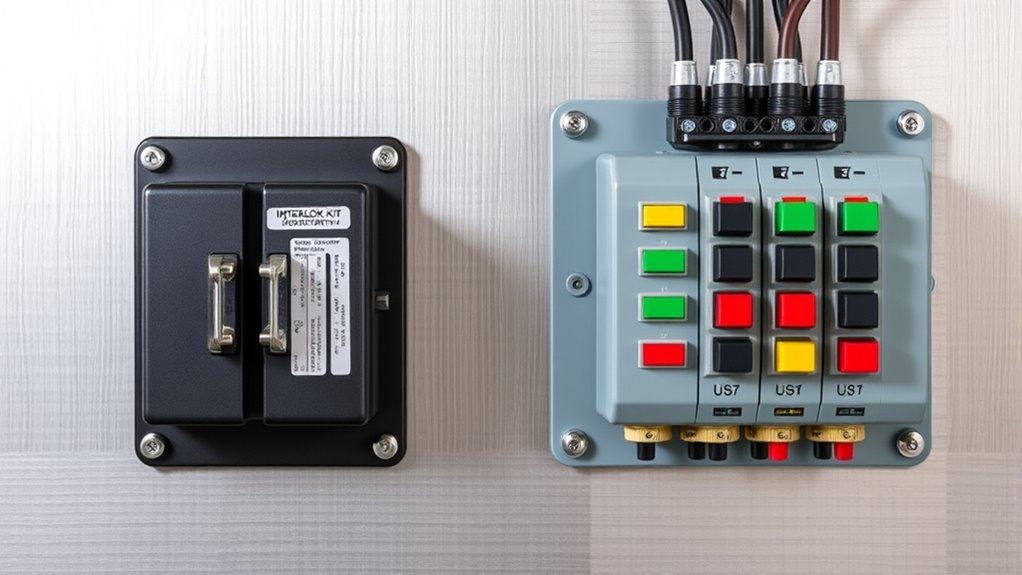
If you need a simple, budget-friendly solution for whole-house backup, an interlock kit might be your best choice. For more targeted power needs, like specific circuits or essential appliances, a transfer switch offers better control and safety. Understanding your panel compatibility and power requirements will help you choose the right system for your setup. Interlock kits are typically easier to install and can be a practical solution for those comfortable with DIY projects, especially when whole-house coverage is sufficient. Additionally, considering the electrical load and ensuring your system can handle the required power will help prevent potential issues during operation.
Suitable for Whole-House Backup
Are interlock kits and transfer switches suitable options for whole-house backup power? Yes, but with conditions. Interlock kits can support entire-house backup if your generator has enough capacity to handle your electrical panel’s load safely. They’re a good budget option for manual operation. Transfer switches, especially automatic models, are designed to manage whole-house loads more efficiently. They can be sized specifically for your entire system and offer better protection and isolation from the utility grid. Transfer switches also enable seamless switching, making them ideal for continuous power needs. If you want reliable, hands-free operation for your whole house, a transfer switch is typically the better choice. Interlock kits work well for simpler setups or DIY projects, but transfer switches provide more all-encompassing, automatic whole-house backup solutions. Additionally, understanding electrical safety protocols is crucial when installing either system to prevent hazards and ensure reliable operation.
Circuit-Specific Applications
When choosing between interlock kits and transfer switches for whole-house backup, considering how they handle specific circuits is key. Transfer switches allow you to power select essential circuits, like medical equipment or refrigeration, preventing overloads. Interlock kits don’t isolate circuits but let you manually control which breakers are active, connecting the entire panel limited by generator capacity. Automatic transfer switches dynamically manage critical loads, ideal for extended outages. Compatibility depends on your panel’s design, breaker types, and generator size. Additionally, understanding the anti-backfeed feature of transfer switches can enhance safety during operation.
User Experience, Convenience, and Operational Control
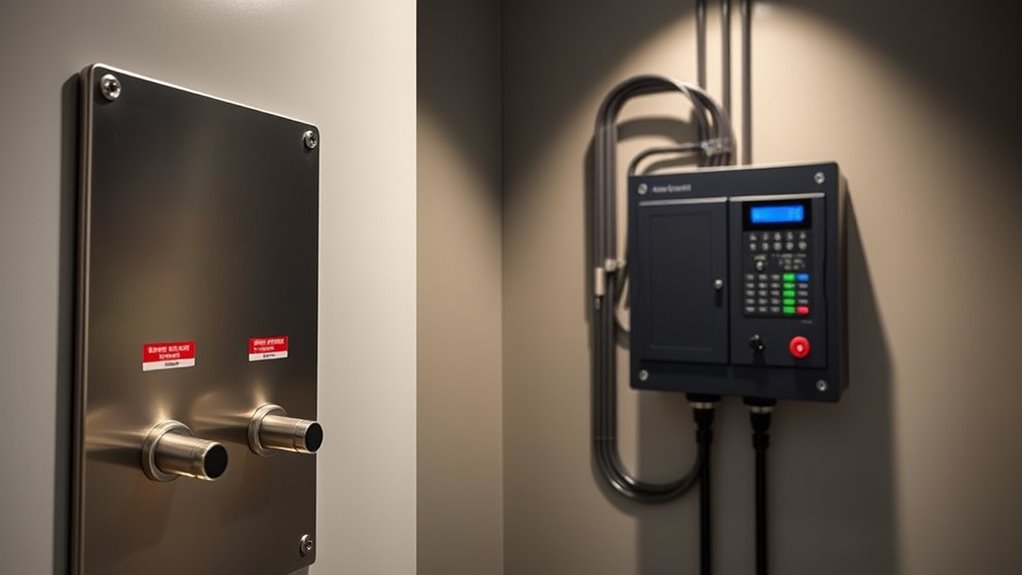
Choosing between interlock kits and transfer switches considerably impacts your experience and control during power outages. Interlock kits require you to manually switch between utility and generator power, giving you direct control but needing your intervention. Transfer switches, especially automatic ones, detect outages and switch sources seamlessly, offering hands-free operation. They provide clear, labeled controls and indicators, reducing confusion and user error. Interlock kits depend on mechanical barriers without visual status indicators, which can be less intuitive. Automatic transfer switches enhance convenience by eliminating the need for physical presence during switching, ideal for extended outages. While interlocks are simpler and more budget-friendly, transfer switches offer greater operational control, safety, and ease of use, making them a more reliable choice for those seeking seamless power management. Additionally, automatic transfer switches are designed with features that protect your home and equipment during power transitions, further enhancing their reliability and safety. Incorporating reliable technology in transfer switches ensures they perform consistently and safely under various conditions.
Frequently Asked Questions
Can Interlock Kits Be Used With All Electrical Panel Brands?
No, interlock kits can’t be used with all electrical panel brands. You need to choose a kit designed specifically for your panel’s manufacturer, like Eaton, Square D, or Siemens. Universal or aftermarket kits often don’t fit properly or meet safety standards. To guarantee safety and compliance, verify that the kit matches your panel model and brand before installation. Always follow manufacturer instructions and local electrical codes.
Do Transfer Switches Require Periodic Maintenance or Testing?
Yes, transfer switches require periodic maintenance and testing to guarantee reliable operation. You should perform annual inspections, including visual checks for damage, corrosion, or dust buildup, and conduct monthly load tests to verify they switch correctly under real conditions. Regular testing helps identify issues early, prevents failures during outages, and extends the switch’s lifespan. Always follow manufacturer guidelines and standards like NFPA for proper maintenance routines.
Are Automatic Transfer Switches Compatible With Smart Home Systems?
Think of your smart home as a symphony, and the transfer switch as a conductor. Most automatic transfer switches aren’t natively compatible with smart home systems, but some, like the EcoFlow Smart Home Panel, can integrate with multiple energy sources and be controlled centrally. You’ll likely need additional smart controllers or professional installation to connect them seamlessly, especially since many don’t support direct communication protocols like Wi-Fi or Z-Wave.
How Long Does Installation Typically Take for Each System?
You can expect ignition interlock devices to take about 2 hours for installation, with some vehicles needing more time if they’re complex. Generator interlock kits usually install in a few hours, especially if you’re doing it yourself with basic tools. Transfer switches take longer, often half a day or more, since they involve more wiring and professional installation. The exact time varies based on your system’s complexity and local regulations.
Is Professional Installation Mandatory for Interlock Kits?
Yes, professional installation is highly recommended for interlock kits. You don’t want to bite off more than you can chew, especially with electrical safety on the line. Most manufacturers and local codes require a licensed electrician to make sure everything’s wired correctly and safely. Doing it yourself might save money upfront, but it can lead to costly mistakes or violations that put you and your home at risk.
Conclusion
Choosing between interlock kits and transfer switches is like selecting the right key for your home’s safety. Both enable peace of mind, but each has its unique rhythm and purpose. By understanding their functions, costs, and safety features, you can make a confident decision. Remember, this choice is your safeguard against power outages—your shield in the storm. Pick the right system, and you’ll keep your home running smoothly, no matter what life throws your way.



